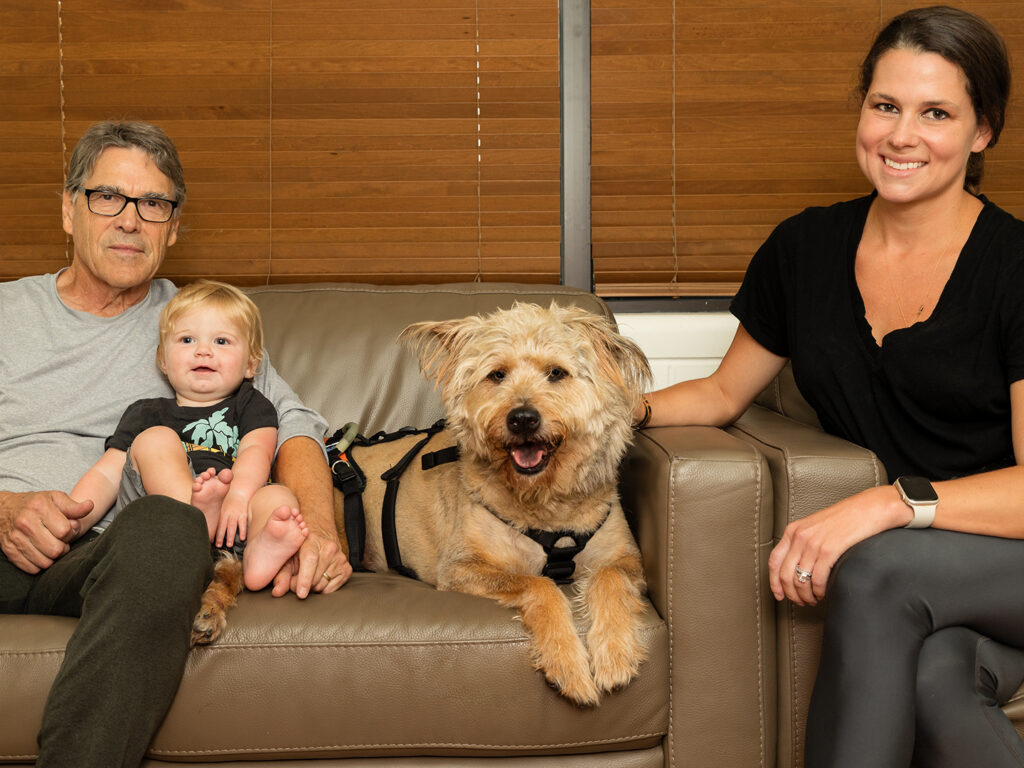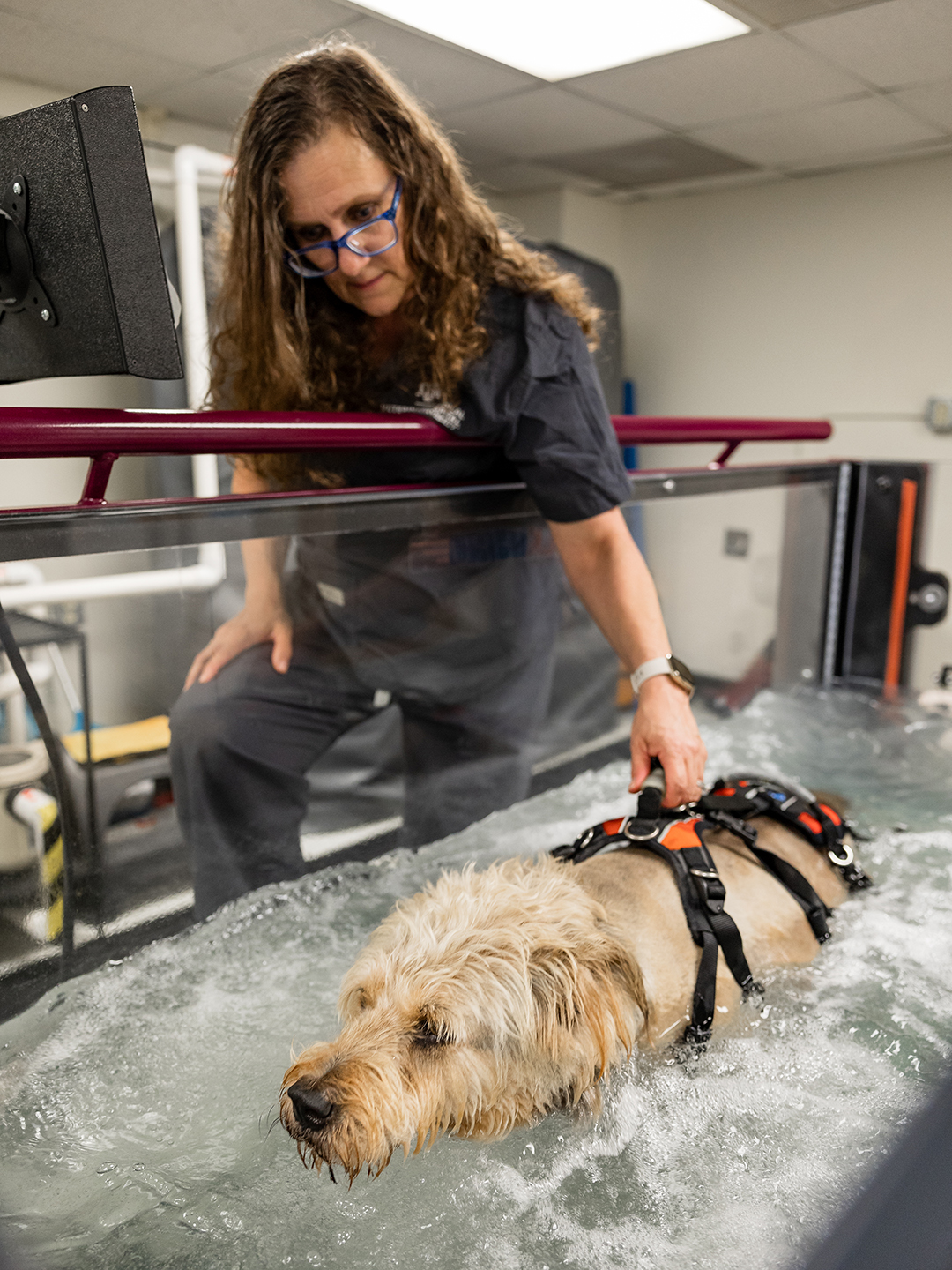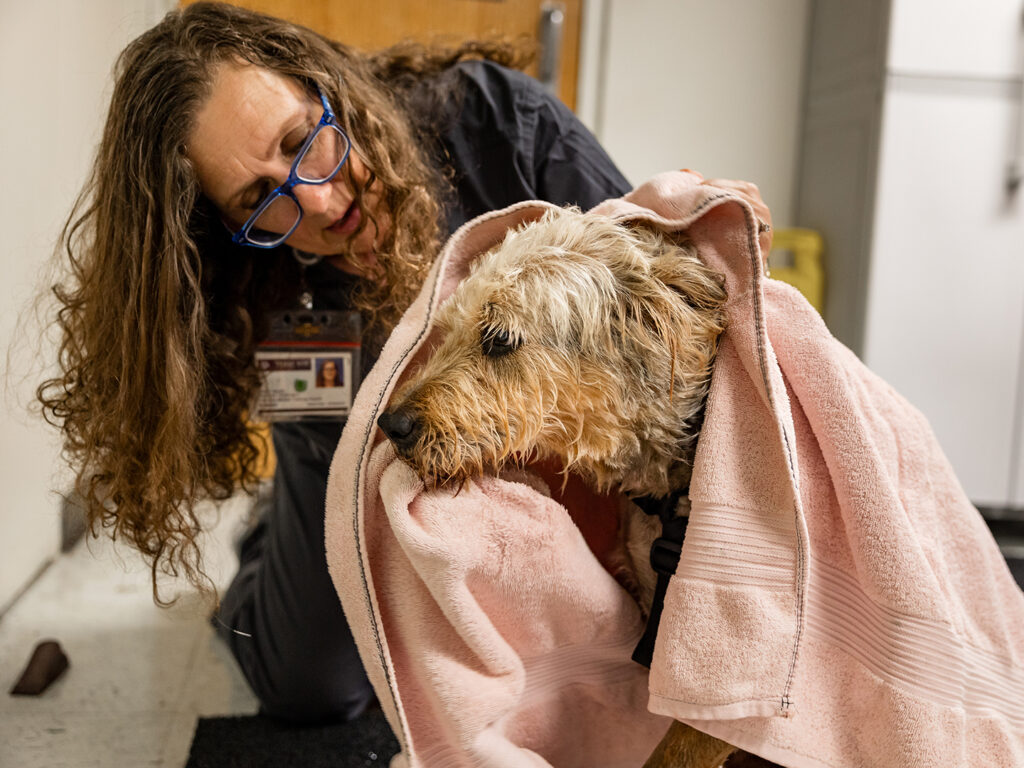Perry Family Turns To Texas A&M Veterinary Rehabilitation To Support Beloved Dog’s Quality Of Life
Story by Megan Myers, VMBS Communications

Having gone from a hoarding situation in Tijuana to the governor’s mansion in Austin, Scout Perry has seen the lows and highs of life.
Most recently, despite being faced with a discouraging medical diagnosis, the 11-year-old mixed breed dog has fought valiantly and found both solace and friendship at the Texas A&M Small Animal Teaching Hospital (SATH).
In April 2022, Scout was diagnosed with degenerative myelopathy (DM), which is comparable to Lou Gehrig’s Disease in people. This rare condition has no cure but can be treated with physical rehabilitation.
DM progresses over time and affected dogs traditionally only survive about six months after diagnosis. However, with the unending support of one of the most recognizable families in Texas, Scout continues to run on Texas A&M’s underwater treadmill, spend time with his family, and love life almost a year and a half after his diagnosis.
Humble Beginnings
Scout has been a member of the Perry family for more than a decade. He was adopted by Sydney Perry, daughter of former Texas Gov. Rick Perry, and her husband in 2013.
“My husband was in the Navy and was stationed in San Diego,” Sydney said. “On Saturdays, a group called Baja Dog Rescue brought puppies up from Tijuana to Petco, and we were just going to go look. We walked up and there was the cutest dog you’ve ever seen with an ‘adopt me’ vest on.”
After falling in love with Scout at first sight, the couple learned that his life had already included great hardship.
“Scout had been severely abused. They found him tied up in an abandoned hotel where somebody was hoarding 200 dogs,” she said. “He was 5 months old and had been returned twice because he would urinate when scared and bark at strangers. My husband was the only person he didn’t bark at.”
Within hours of being adopted, Scout was bonded with his new family members and refused to leave their sides. He lived with them in San Diego until the couple returned home to Texas, where Scout was accepted into Rick and Anita Perry’s “dog pack” at the governor’s mansion.
As the years passed, Scout stayed with Rick and Anita as they moved out of the governor’s mansion and into a new home in Austin in 2015 while continuing to see Sydney and her husband regularly. As Scout aged, his owners began to notice symptoms of what appeared to be arthritis.
“He started dragging one back foot; we just thought he was old and had arthritis or a pinched nerve in his back,” Sydney said.
But when the tests came back and Scout received his diagnosis, the family was stunned to find out that Scout’s condition was much worse than they had anticipated.
Making The Diagnosis

The Perrys have been SATH clients for many years, so Texas A&M’s Neurology Service was their immediate choice for Scout’s veterinary care when they found out he would need specialized treatments.
Scout’s condition was diagnosed by first ruling out other causes of his symptoms, such as disc degeneration or cancer and then by performing a blood test that looks for the genetic mutation that causes DM.
“Degenerative myelopathy is a neurodegenerative disease that affects the spinal cord of dogs,” said Dr. Joseph Mankin, a veterinary neurosurgeon and clinical associate professor at the Texas A&M School of Veterinary Medicine & Biomedical Sciences.
“It is a slowly progressive disease that starts as a weakness in their back legs but progresses to where they cannot use their back legs at all,” he said. “The disease will eventually affect their front legs as well.”
Although receiving this diagnosis was heartbreaking for the Perrys, they knew that Scout would receive the best possible treatment at the SATH.
“Scout’s the most loyal dog. He would do anything for us, so we want to do whatever it takes to keep him happy and free of pain for as long as possible,” Sydney said. “Even though he’s been through so much, he’s just a good boy.”
Finding Relief
“The only thing clinically proven to extend longevity when dogs are diagnosed with DM is rehab — strengthening muscles and keeping them moving,” said Sherri Jerzyk, a veterinary technician in the Sports Medicine & Rehabilitation Service. “Originally, Scout was still mobile but having some difficulty walking. He just needed a little bit of assistance.”
Scout began a rehab regimen that focused on increasing his strength and control of his body, as well as acupuncture for pain management and laser therapy to manage wounds caused by dragging his feet.
Scout’s family was also tasked with doing exercises at home, providing a cart that allows him to run outside, and finding new ways to spend time together and keep him mentally stimulated.
As time went on, Scout’s weakness progressed and by February 2023, he could no longer stand or walk on his own. He transitioned from doing both land and water exercises to only using the underwater treadmill, which provides both strength training and cardiac conditioning.
“Scout is a very independent, active dog, and the underwater treadmill gives him a place where he can run without help,” Jerzyk said. “The water holds his weight up and supports his back end, and he flat out runs. He’s as fast as the agility dogs that come to use the underwater treadmill.”
Scout’s twice-a-week underwater treadmill appointments also help maintain his cardiac function, which tends to decrease as dogs become less active, leaving them feeling tired and depressed.
“He’s still able to do something that he really loves to do, which definitely improves his quality of life,” Jerzyk said. “The pressure exerted by the water also helps disperse inflammation out of his tissues and muscles, and that makes him feel better as well.”
Focusing On What’s Important

More than 14 months after his diagnosis, Scout continues to be a happy dog and looks forward to his rehab appointments at Texas A&M.
“When Scout first came, he wasn’t a giant fan of rehab,” Jerzyk said. “But soon he settled into the water and now he literally drags us to the underwater treadmill and climbs straight in.
“I love his big personality. He really commands a room when he walks in,” she said. “He’s the second dog we have right now that is past their expected lifespan from when they were diagnosed. I guarantee this dog is going to surprise us all, and part of it is because of that big personality.”
Scout may not be moving as quickly or independently as he used to, but his rehabilitation at the SATH has given him and his family many more months of quality time together.
“Our goal with rehab is not about curing the disease — it’s about helping this dog spend as much quality time with his family as he can,” Jerzyk said. “He’s still very mentally alert. You can’t judge him by his function right now; you have to judge him by his quality of life, and he definitely has that.”
For the Perry family, every additional day with Scout is a gift.
“He’s still Scout and he’s happy — that’s the most important thing for us,” Sydney said. “We’re so grateful to Dr. (Daniel) Eckman, Sherri, and Heidi (Gaddis, SATH administrative associate) for giving us this extra time with him. We have had so much more time because of what they’ve done for him here.”
###
For more information about the Texas A&M School of Veterinary Medicine & Biomedical Sciences, please visit our website at vetmed.tamu.edu or join us on Facebook, Instagram, and Twitter.
Contact Information: Jennifer Gauntt, Director of VMBS Communications, Texas A&M School of Veterinary Medicine & Biomedical Sciences, jgauntt@cvm.tamu.edu, 979-862-4216


